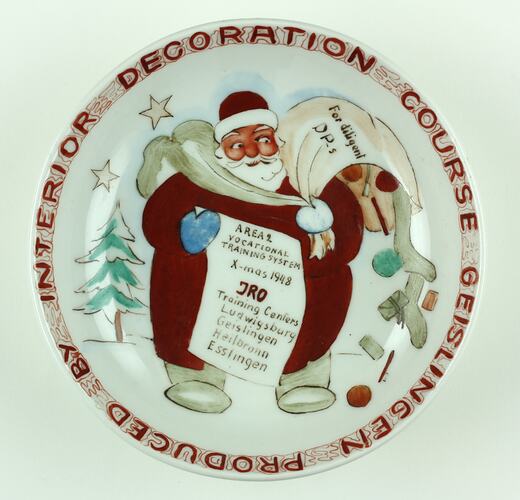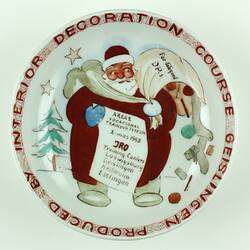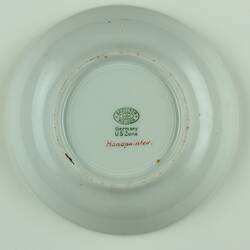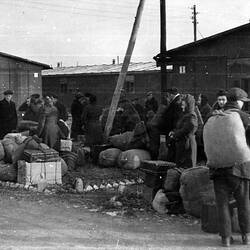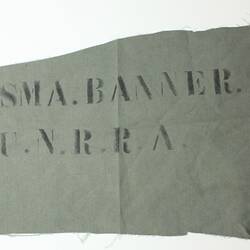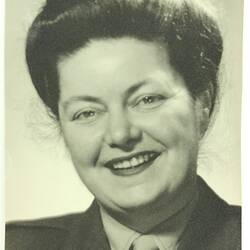Summary
Hand painted plate collected by UN World War II displaced persons' camp worker Esma Banner between 1945 and 1951. It features Father Christmas and is inscribed with a list of camp names and the name of the decoration training course. It was created for Christmas by a displaced person at an interior decoration course at Geislingen Displaced Persons Camp in Germany as part of the camp's Vocational Training System in 1948.
Esma Banner worked in displaced persons' camps in the US Zone of Germany after World War II as an employment and welfare officer for the United Nations Relief and Rehabilitation Administration (UNRRA) and the International Refugee Organization (IRO), from 1945 to 1951. Esma was one of 39 Australians who went to Germany to assist with post-war repatriation and re-settlement of refugees displaced by the war. More than 1000 displaced persons' camps were established by the Allied Forces. Initially created as temporary processing centres, the camps became longer term sites of accommodation, employment, education and recreation for refugees who could not, or did not want to, be repatriated to their countries of origin.
Esma acquired examples of textiles, woodwork, leatherwork and other traditional craftwork from displaced persons' who made them from predominantly recycled and donated materials. While many traditional handcrafts were made out of necessity, others were made as a means to pass time, to express cultural identity, and occasionally to sell or exhibit. During the course of her time in Germany, Esma sent these objects home to her family in Australia.
Physical Description
This handpainted dish reads 'PRODUCED BY INTERIOR DECORATION COURSE GEISLINGEN' written in red lettering around the rim of the dish. It features a hand painted picture of Santa Clause who is carrying a sack filled with presents on which is written 'For Diligent DPs'. Santa holds a scroll that lists 'Area 2, Vocational Training System, X-Mas 1948, IRO, Training Centers, Lydwigsburg, Geislingen, Heilbronn, Esslingen'. The object appears to be a standard issue plate used at the camps, with a stamp on the back of the dish that reads 'Bauscher weiden, Germany US Zone'. The word 'Handpainted.' has been handpainted on the back of the plate in red.
Significance
The Esma Banner World War II UN Worker Collection is an extensive and diverse collection of objects, documents, photographs and archival material which explores the experiences of an Australian woman working for the United Nations assisting in the relief and rehabilitation of millions of displaced people in Europe after World War II. Esma Banner served with the United Nations Relief and Rehabilitation Administration (UNRRA) and later with the International Refugee Organization (IRO) at displaced persons' camps in Germany from 1946 to 1951. She was one of fewer than 40 Australians employed by UNRRA and IRO during this period.
This collection recounts the often untold story of immigration from the perspective of a migration worker and enables the documentation of many themes relating to post World War II migration including life in the displaced person camps, international refugee management, creativity and cultural maintenance, and the political complexities of post-war resettlement. Of particular note are the craft items created by refugees living in displaced persons' camps. This collection holds a variety of men's and women's work, thus providing a significant insight into life within the camps. These objects also serve as valuable examples of cultural practices and traditional skills.
This collection and accompanying documentation presents a unique perspective of the post-World War II relief effort. Esma's diaries and letters in particular offer her personal insights and observations and demonstrate how civilians contributed to the reconstruction effort in Europe. In addition, these items add to the emerging collections of material describing women's involvements during times of conflict, as well as the larger narratives that illustrate Australia's wartime experience. After World War II hundreds of thousands of homeless, stateless or displaced people lived in camps before resettling in Western countries including Australia. This collection retains ongoing cultural relevance to these large migrant communities across Victoria and Australia. With the population of post-war displaced persons' survivors aging, the collection contributes to preserve their stories and experiences as part of a greater Australian migration narrative.
More Information
-
Collection Names
-
Collecting Areas
-
Acquisition Information
Donation from Helen Fitzgerald, 14 Mar 2012
-
Place & Date Made
-
Collector
-
Inscriptions
Front: 'PRODUCED BY INTERIOR DECORATION COURSE GEISLINGEN/ For Diligent DPs/ Area 2, Vocational Training System, X-Mas 1948, IRO, Training Centers, Lydwigsburg, Geislingen, Heilbronn, Esslingen' Reverse: 'Bauscher weiden, Germany US Zone'
-
Classification
-
Category
-
Discipline
-
Type of item
-
Overall Dimensions
30 mm (Depth), 130 mm (Circumference)
-
Keywords
Displaced Persons, Displaced Persons Camps, Crafts, Crockery, Paintings, Homecrafts, Home Decorating, World War II, 1939-1945, Cultural Traditions, National Identity, Wars & Conflicts, Christmas, Interior Design, Vocational Training, Handcrafts, Cultural Identity, Migration & Settlement, Plates, Dishes, Santa Claus, Refugees
